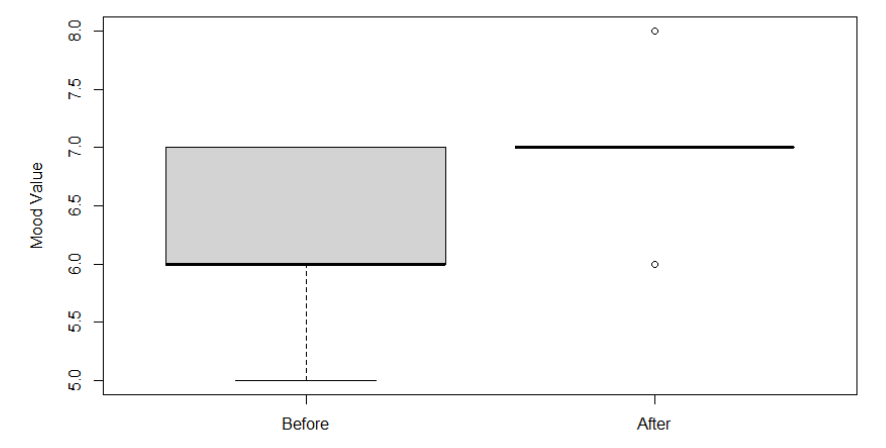Audio Trip – A Comparison Between Regular and Cardio Levels


Audio Trip: A Comparison Between Regular and Cardio Levels
Abstract
Audio Trip, a VR dance rhythm game, was designed by Kinemotik Studios to promote physical activity through dance. The present study investigated the differences between the Regular and Cardio difficulty levels within the game, hypothesising that players will experience higher heart rates and rates of perceived exertion compared to those at the Regular difficulty level. Additionally, the research explored broader mood outcomes associated with playing Audio Trip, hypothesising a general improvement in mood after play.
The results indicated a significant increase in percentage maximum heart rate reached, average percentage of maximum heart rate, and percentage heart rate reserve, during Cardio levels compared to Regular levels. This highlights the benefits of Cardio gameplay for increased caloric burn and weight loss, contributing to overall health improvements. Participants reported significantly higher RPE in Cardio levels, reinforcing the link between perceived exertion and heart rate. Positive mood enhancement post-gameplay aligns with existing research on the psychological benefits of immersive VR experiences.
While acknowledging the limitations, such a small sample size, and the need for further research on long-term effects, this study emphasises the significant implications for VR game development focused on physical activity and health. The success of Audio Trip’s Cardio levels highlights the potential for VR gaming to positively impact both mental and physical well-being.
Introduction
Recent research has shown virtual reality (VR) to be an effective tool for implementing immersive gamification of exercise, providing a fun and engaging experience to improve both mental and physical well-being. Audio Trip, developed by Kinemotik Studios, is a VR dance rhythm game which is designed to promote physical activity through dance choreography. The game offers multiple difficulty levels, including Beginner, Regular, Advanced, and Cardio. The Cardio levels have been designed to promote large full-body movements while minimising cognitive load, with the primary goal of enhancing cardiovascular health through simple, repetitive aerobic exercises.
It is hypothesised that participants playing the Cardio levels will experience a significantly higher heart rate (HR) and rate of perceived exertion (RPE) compared to those playing at the Regular difficulty level. The anticipated increase in heart rate during the Cardio levels suggests the potential for more pronounced cardiovascular benefits, including a higher metabolic rate and therefore higher caloric burn. This study seeks to empirically test these hypotheses by examining whether statistically significant differences exist in heart rate and RPE between the Regular and Cardio difficulty levels.
Furthermore, this research aims to evaluate the broader mood outcomes associated with playing Audio Trip, to shed light on the potential psychological benefits of this VR experience.
Methods
5 healthy participants (3 male and 2 female) aged 24-33 were recruited to participate. Participants were required to be familiar with Audio Trip and be able to play both regular and cardio levels without failing the level.
An informed consent form was completed before a questionnaire including information about demographics and current mood. Participants were fitted with a Polar H10 HR monitor and asked to sit down and relax for the first 5 minutes to record a resting heart rate and ensure participants began to play from a resting heart rate. The starting difficulty level (Cardio or Regular) was determined randomly.
Participants completed the songs Krishna and Red on the first difficulty, with a 30 second break in between. The ‘No Fail’ modifier remained off throughout to ensure participants were completing the level with the choreographed movements. Participants were then given a 5 minute break, in which they indicated their RPE for whilst they were playing, on Borg’s scale of 6-20. The songs Krishna and Red were then repeated on the other difficulty, again with a 30 second break in between. Once finished, participants answered a final questionnaire including information about their RPE whilst playing on the second difficulty and their current mood.
Data Analysis
Data analysis was conducted using RStudio, a programming environment in the R programming language. A significance level of α = 0.05 was employed, corresponding to a 95% confidence interval. To ensure data accuracy, anomalous data points resulting from brief heart rate monitor disconnections were excluded from the analysis.
To estimate each participant’s maximum HR (HRmax), the equation 208 – 0.7 × age was utilised, following the approach outlined in Tanaka, Monahan, and Seals (2001). Subsequently, the maximum HR achieved during gameplay, as well as the average HR during gameplay, were divided by their estimated HRmax to obtain the percentage of HRmax reached (%HRmax) and the average percentage of HRmax during play (%HRavg). Percentage heart rate reserve (%HRR) was calculated using (HR activity−resting HR)/(predicted HRmax−resting HR)×100 (Caballero, Ando & Nakae et al., 2020).
To compare the data between the Regular and Cardio difficulty levels, %HRmax, %HRavg, %HRR and RPE data were analysed. Data were first assessed for normality, then a paired samples t-test was employed to evaluate the differences in data between the Cardio and Regular difficulty levels. Finally, mood scores before and after were analysed, again using a paired samples t-test after normality testing.
Results
Heart Rate & RPE
%HRmax was found to be significantly higher (t(5.629)=4, p=0.0049) in the Cardio levels, with a mean of 75±12.1 in the Regular levels and 84.3±11.2 in the Cardio levels. There was an average difference of 9.32% (~17.4 BPM). Figure 1 shows a box plot of the differences in %HRmax between the Cardio and Regular levels.
Figure 1
Comparison of %HRmax between Regular and Cardio levels
%HRavg was found to be significantly higher (t(7.0044)=4, p=0.002187) in the Cardio levels than the Regular levels, with a mean of 62.7±11.2 in the Regular levels and 71.6±13 in the Cardio levels. There was an average difference of 8.87% (~16.6 BPM). Figure 2 shows a box plot of the differences in %HRavg between the Cardio and Regular levels.
Figure 2
Comparison of %HRavg between Regular and Cardio levels
%HRR was found to be significantly higher (t(6.7693)=4, p=0.002485) in the Cardio levels than the Regular levels, with a mean of 45.7±14.3 in the Regular levels and 58.8±17.6 in the Cardio levels. There was an average difference of 7.74%. Figure 3 shows a box plot of the differences in %HRR between the Cardio and Regular levels.
Figure 3
Comparison of %HRR between Regular and Cardio levels
RPE was also found to be significantly higher (t(6.7082)=4, p=0.00257) in the Cardio levels than the Regular levels, with a mean of 10.6±0.9 in the Regular levels and 13.6±1.7 in the Cardio levels. There was an average difference of 3. Figure 4 shows a box plot of the differences in RPE between the Cardio and Regular levels.
Figure 4
Comparison of RPE between Regular and Cardio levels
Mood
Mood was found to have improved after play, with a significant difference (t(-4)=4, p=0.01613), with a mean of 6.2±0.7 before play and 7±0.8 after play, and a mean difference of 0.8. Figure 5 shows a box plot of the differences in mood before and after play.
Figure 5
Discussion
The present study set out to explore the influence of different gameplay levels in the VR dance rhythm game, Audio Trip, on participants’ HR, RPE, and mood. The outcomes present significant findings that not only shed light on the potential health and psychological benefits of this VR experience but also have practical implications for important factors such as increased calorie burn, weight loss, and overall health.
Heart Rate
The analysis of heart rate data revealed a significant difference between the Regular and Cardio levels. %HRmax, %HRavg and %HRR were all significantly higher in the Cardio levels. These findings align with the well-established fact that more physically demanding gameplay, as offered in the Cardio levels, leads to a higher heart rate (Deterding et al., 2011). Importantly, this link between increased physical exertion and higher heart rate, as seen in the Cardio levels, increases metabolic rate and caloric burn.
It is well known that a higher heart rate during exercise results in a higher energy expenditure (Crouter, Churilla, & Bassett, 2006). Therefore, the Cardio levels, with their ability to elevate heart rate significantly, can be a valuable tool for those aiming to maximise caloric burn and achieve weight loss goals. Research has highlighted the numerous health advantages associated with maintaining a healthy weight, including a reduced risk of chronic diseases such as diabetes, cardiovascular conditions, and certain cancers (Khan et al., 2018). Additionally, maintaining a healthy weight contributes to overall quality of life, including increased physical functioning and vitality, decreased pain and improved psychological well-being (Lavie et al., 2018).
One participant commented “I found Krishna on Regular mode much harder skill wise then the Cardio mode”, which supports the success of the developer’s goals of enhancing cardiovascular health, while minimising cognitive load.
Rate of Perceived Exertion
This study also assessed participants’ perceived exertion, using Borg’s RPE scale. RPE scores were significantly higher in the Cardio levels than the Regular levels, reflecting the participants’ perception of the Cardio levels as more physically demanding. This aligns with the higher heart rates observed in the Cardio levels, reinforcing the connection between perceived exertion and heart rate.
Mood and Psychological Benefits
Over the past few years, it has been well-established that gamified VR can be beneficial for psychological well-being, particularly when combined with physical activity. It has been shown to improve mood (Hoolahan, 2020) and assist with depression and anxiety (Baghaei et al., 2018), as well as other psychological disorders (Emmelkamp & Meyerbröker, 2021).
The present study assessed mood outcomes and found a significant improvement in mood after gameplay. This positive mood enhancement aligns with the broader psychological benefits of engaging in immersive VR gaming experiences. One participant commented that “It made me feel positive and upbeat” which highlights the positive impact on mood that was felt by participants. This result supports previous research that indicates how VR experiences can positively impact emotional well-being and stress reduction (Hoolahan, 2020; Marques, Uchida, & Barbosa, 2023).
Limitations and Implications
It must be acknowledged that there are also certain limitations which should be considered alongside the conclusions made from this study. The small sample size of 5 participants limits the generalizability of the findings. Further research should be conducted to support these findings on a wider scale. Additionally, the single session of play will likely not fully capture the long-term effects of immersive gaming on health and well-being.
These findings have significant implications for the development of VR games intended for physical activity, weight management, and overall health. The results underscore the importance of game modes, music, and the link between heart rate and caloric burn.
With immersive VR headsets becoming more accessible and popular worldwide, it provides a unique platform for the gamification of exercise which is both fun and engaging, without the elements of novelty which have been seen in less immersive ‘VR’ solutions such as the Xbox Kinect and Nintendo Wii (Hoolahan, 2020). With obesity being such a prevalent issue worldwide it is vitally important that the promotion of physical activity through VR and gamification is pushed forward, with research such as the present study continuing to provide important insights to improve the development of games, such as Audio Trip, towards improving user’s health and well-being.
Conclusion
In conclusion, the Cardio levels in Audio Trip have been shown to be successful in enhancing cardiovascular health, through simple aerobic movements. Compared to the Regular levels, the Cardio levels induced a higher %HRmax, %HRavg, %HRR and RPE.
This study demonstrates the potential of VR gaming, exemplified by Audio Trip, not only to improve mental well-being and promote physical activity, but to adapt gameplay to increase heart rate and burn more calories, supporting weight management goals and thereby encouraging a healthier and happier lifestyle.
With the growing popularity and accessibility of VR, it is important for game developers to be aware of the potential benefits, to both mental and physical well-being, that their games can provide, optimising those benefits where possible, as Kinemotik Studios appear to have done successfully with Audio Trip. Further research should be completed to support the conclusions from this study. Further research to investigate how different movements can be induced and implemented to improve upon the physical benefits gained from VR games, would also be beneficial to give developers more insight when developing these VR games.
References
Baghaei, N., Chitale, V., Hlasnik, A., Stemmet, L., Liang, H.-N., & Porter, R. (2021). Virtual Reality for Supporting the Treatment of Depression and Anxiety: Scoping Review. JMIR Mental Health, 8(9), e29681. https://doi.org/10.2196/29681
Borg, G. A. (1982). Psychophysical bases of perceived exertion. Medicine & Science in Sports & Exercise, 14(2), 377–381. https://pubmed.ncbi.nlm.nih.gov/7154893/
Caballero, Y., Ando, T. J., Nakae, S., Usui, C., Aoyama, T., Nakanishi, M., Nagayoshi, S., Fujiwara, Y., & Tanaka, S. (2020). Simple prediction of metabolic equivalents of daily activities using heart rate monitor without calibration of individuals. International Journal of Environmental Research and Public Health, 17(1). https://doi.org/10.3390/IJERPH17010216
Crouter, S. E., Churilla, J. R., & Bassett, D. R. Jr. (2006). Estimating energy expenditure using accelerometers. European Journal of Applied Physiology, 98(6), 601-612
Deterding, S., Dixon, D., Khaled, R., & Nacke, L. (2011). From game design elements to gamefulness: defining “gamification.” In Proceedings of the 15th international academic MindTrek conference: Envisioning future media environments (pp. 9-15)
dos Anjos, L. A., da Mata MacHado, J., Wahrlich, V., de Vasconcellos, M. T. L., & Caspersen, C. J. (2011). Absolute and relative energy costs of walking in a Brazilian adult probability sample. Medicine and Science in Sports and Exercise, 43(11), 2211–2218. https://doi.org/10.1249/MSS.0B013E31821F5798
Emmelkamp, P. M. G., & Meyerbröker, K. (2021). Virtual Reality Therapy in Mental Health. Annual Review of Clinical Psychology, 17, 495–519. https://doi.org/10.1146/ANNUREV-CLINPSY-081219-115923
Hoolahan, K. (2020). A Preliminary Investigation Into the Effects of Gamified Virtual Reality on Exercise Adherence, Perceived Exertion, and Health. International Journal of Virtual and Augmented Reality (IJVAR), 4(2), 14–31. https://doi.org/http://doi.org/10.4018/IJVAR.2020070102
Karageorghis, C. I., & Priest, D. L. (2012). Music in the exercise domain: a review and synthesis (Part I). International Review of Sport and Exercise Psychology, 5(1), 44-66
Khan, S. S., Ning, H., Wilkins, J. T., Allen, N., Carnethon, M., Berry, J. D., Sweis, R. N., & Lloyd-Jones, D. M. (2018). Association of Body Mass Index With Lifetime Risk of Cardiovascular Disease and Compression of Morbidity. JAMA Cardiology, 3(4), 280. https://doi.org/10.1001/JAMACARDIO.2018.0022
Lavie, C. J., Laddu, D., Arena, R., Ortega, F. B., Alpert, M. A., & Kushner, R. F. (2018). Healthy Weight and Obesity Prevention JACC Health Promotion Series. https://doi.org/10.1016/j.jacc.2018.08.1037
Marques, L. M., Uchida, P. M., & Barbosa, S. P. (2023). The impact of Exergames on emotional experience: a systematic review. Frontiers in Public Health, 11. https://doi.org/10.3389/FPUBH.2023.1209520
Purchase Audio Trip
You can purchase Audio Trip on Steam, Oculus Quest and Oculus Rift by clicking on the appropriate link here.






